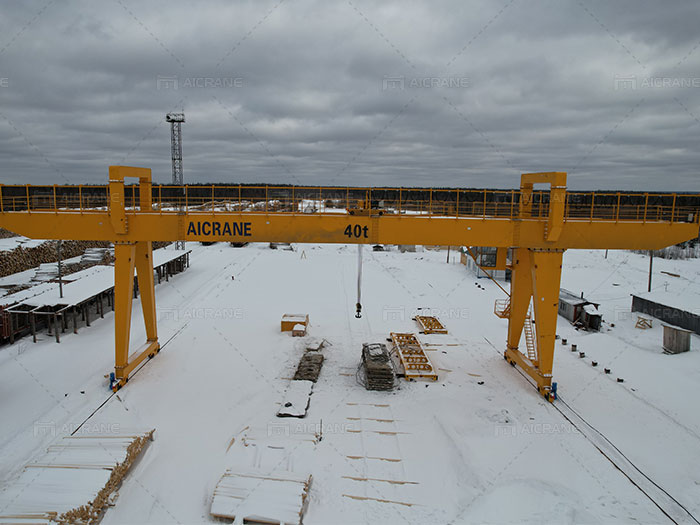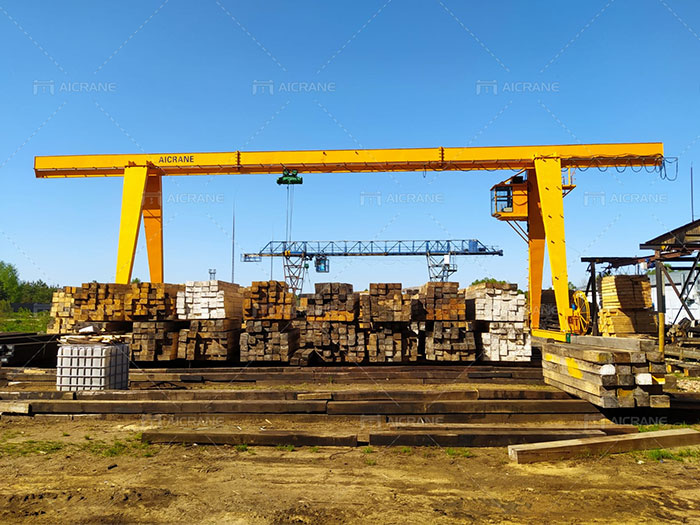When selecting a gantry crane for lifting heavy loads in industrial and commercial applications, one of the most critical decisions is choosing between a single girder gantry crane and a double girder gantry crane. Both options have their advantages, but the cost factor plays a significant role in determining which crane is more suitable for a particular project. This article will explore the key cost differences between single girder and double girder gantry cranes, highlighting factors such as initial purchase price, operational costs, and long-term maintenance.

1. Understanding Single Girder and Double Girder Gantry Cranes
Before diving into the cost analysis, it’s important to understand the basic differences between these two types of gantry cranes.
-
Single Girder Gantry Crane: As the name suggests, this single girder gantry crane for sale features a single horizontal beam or girder that supports the lifting mechanism. The crane runs on rails, and the hoist moves along the length of the girder. Single girder cranes are typically used for lighter-duty applications and are ideal for warehouses, manufacturing plants, and smaller construction projects.
-
Double Girder Gantry Crane: A double girder gantry crane has two parallel girders that support the lifting mechanism. This design provides more stability, allowing for higher lifting capacities and greater spans compared to single girder cranes. Double girder cranes are commonly used in heavy-duty applications such as steel mills, ports, and large industrial facilities where higher load capacities and longer spans are required.

2. Initial Purchase Price
One of the first cost differences you’ll encounter between single girder and double girder gantry cranes is the initial purchase price. Generally, double girder cranes tend to be more expensive than their single girder counterparts.
-
Single Girder Gantry Cranes: Due to their simpler design, lighter structure, and fewer components, single girder gantry cranes are less expensive to manufacture. Their cost typically ranges between 20% to 40% lower than double girder models. The single girder crane is a more economical choice for businesses that need a crane with a lower lifting capacity or shorter span.
-
Double Girder Gantry Cranes: Double girder gantry cranes require more material (steel), more advanced design, and additional components, all of which contribute to a higher initial cost. These cranes are typically 30% to 50% more expensive than single girder cranes due to their enhanced stability, higher lifting capacities, and larger spans.
3. Load Capacity and Lifting Height
The lifting capacity and height of the crane have a direct impact on the gantry crane price. Double girder cranes are generally used in applications where heavy loads need to be lifted, such as in the steel industry, heavy manufacturing, or container ports.
-
Single Girder Gantry Cranes: These cranes are suitable for lighter loads (up to 20 tons) and are typically used in applications where the load is not excessively heavy. As a result, their lower lifting capacity reduces material costs and manufacturing complexity, making them more affordable.
-
Double Girder Gantry Cranes: Double girder cranes can lift much heavier loads (from 20 tons to over 500 tons) and are designed for demanding industrial environments. They are often required in industries like construction, mining, and heavy manufacturing. The increased load capacity and lifting height capability increase both material costs and design complexity, contributing to a higher price tag.
4. Operational Efficiency and Energy Consumption
While the initial cost of a double girder crane is higher, it can potentially save money in the long term due to its operational efficiency and energy consumption. Double girder cranes tend to be more efficient for heavier lifting tasks, requiring less effort to lift heavy loads compared to single girder cranes.
-
Single Girder Gantry Cranes: These cranes are ideal for lighter loads and generally consume less power when compared to double girder cranes. However, they may not be suitable for operations that require frequent lifting of heavy materials, which could lead to increased wear and tear and inefficient use over time.
-
Double Girder Gantry Cranes: The design of double girder cranes enables them to handle higher loads with less stress on the system, which can result in more energy-efficient operation in demanding tasks. Their ability to manage larger loads without straining the motors or mechanical components often translates into lower energy consumption for high-load operations.
5. Maintenance and Lifespan
Another important cost factor to consider when comparing single girder and double girder gantry cranes is maintenance. The maintenance requirements and associated costs can vary significantly depending on the gantry crane type.
-
Single Girder Gantry Cranes: Due to their simpler design, single girder cranes tend to have lower maintenance costs. They have fewer components and are easier to repair. Routine maintenance, such as checking the hoist, lubricating the parts, and inspecting the rails, is less complicated and less expensive. However, their lower lifting capacity can result in higher maintenance costs in the long term if the crane is not sufficient for the required workload.
-
Double Girder Gantry Cranes: Double girder cranes are more complex, with more parts that require maintenance, such as the additional girder and the more sophisticated hoisting mechanisms. As a result, maintenance costs for double girder cranes tend to be higher. On the other hand, the longer lifespan and higher reliability of double girder cranes mean that, despite the higher maintenance costs, they may provide better value over time for heavy-duty operations.
6. Space and Design Considerations
The space available for crane installation can also influence the cost-effectiveness of a single girder versus double girder gantry crane.
-
Single Girder Gantry Cranes: These cranes require less vertical space because of their simpler design, making them ideal for facilities with limited ceiling height. Their more compact design also reduces construction costs in terms of space preparation, such as reinforcement of floors or structural support.
-
Double Girder Gantry Cranes: These cranes require more vertical space to accommodate the double girder system. In buildings with limited ceiling height or confined space, retrofitting or adjusting the facility to accommodate a double girder crane can increase the overall installation costs. This extra space requirement must be factored into the total cost of ownership.
7. Conclusion: Which Crane Is More Cost-Effective?
The choice between a single girder gantry crane and a double girder gantry crane depends on a variety of factors, including load capacity, facility space, energy efficiency, and long-term maintenance. Here’s a quick summary of when each option might be more cost-effective:
-
Single Girder Gantry Cranes are the better choice for:
- Applications with lighter loads (less than 20 tons).
- Limited budgets and smaller operations.
- Environments where space is constrained.
- Operations where the crane won’t be required for heavy lifting tasks or frequent use.
-
Double Girder Gantry Cranes are the better choice for:
- Heavy-duty operations requiring high load capacities (20+ tons).
- Businesses that plan to operate the crane frequently or for long periods.
- Environments where lifting height and stability are crucial.
- Long-term investments where the crane will provide maximum operational efficiency.
While double girder gantry cranes come with a higher upfront cost, their ability to handle larger loads, greater spans, and more demanding operations means that they can often be the more cost-effective solution for heavy-duty applications in the long run. Conversely, for lighter loads and more budget-conscious operations, a single girder gantry crane may offer the best balance of performance and affordability.
Ultimately, businesses should consider not only the initial purchase price but also the total cost of ownership, which includes operational costs, energy efficiency, and maintenance. Choosing the right crane depends on carefully evaluating the unique requirements of your project and your long-term operational needs.